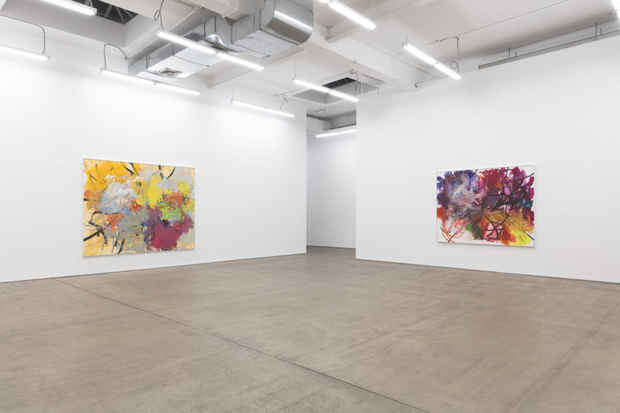Aaron Garber-Maikovska “Channel Light Touch Board”
CLEARING

This event has ended.
Possessing a situationist conviction, Garber-Maikovska composes with the spirit of a nouveau AbEx player pursuing his materials with wild immediacy. He speaks of arbitrating frequencies and asserting them on his polypropylene surfaces, moving in directions that fall apart and then come together in one fell swoop. The paintings are attempts to seize corporeality and relationality in a discrete, visual, energetic form. Action and objective are allied forces under the counsel of Garber-Maikovska’s oil stick.
He creates his own pigments, indexing them to produce a personal museum of chroma. The aliveness of color extends right from the source. As Amy Sillman notes in her essay “On Color,” carmine was historically culled from the cochineal, Tyran purple from the desiccated gland of sea snails. Natural systems reduced to inert substance and then revived in the act of composing an image: life cycles. Of course now the harvesting of pigments is largely consigned to artifice, with shades typically derived from inorganic processes. The sentiment of origins, however, remains conceptually vital within Garber-Maikovska’s framework. By working with raw pigments, he is able to endlessly variate color selection.
Garber-Maikovska advocates for slowing down and being considerate of colors in order to exploit them. This approach is manifest in Desert Flourishes where pigments run the gamut - cold and warm hues are placed in tension while varying degrees of saturation collide against one another. Scumbled color pools also occupy the majority of Spring Swell, where exuberant neons combat muted earth tones. Tiny globs of paint are suspended economically as punctuations within the clouds of pigment.
Lines become pathways between amorphous colorfields. An explosion occurs in Spring Swell, as streams of black fly from the ambiguous core situated on the painting’s right side. The perspective here is noncommittal as the ground is unstable - the board peeks out behind scrapes and scratches. Clustered pigments brazenly pronounce themselves against fluted textures. When describing the material of these surfaces, Garber-Maikovska notes the rhythm of the board. As paint glides across its ridges, a vibrato ensues. The base of each painting contributes dimensionality as the resinous ground provides a shuttered effect beyond the applied oils. Thickened paints combat the shuttered texture whereas diluted swaths succumb to the plastic’s corrugation.
The evolution of all the things that he previously embodied in performance culminates in this exhibition. His performative impulse is being subjugated into these images. Garber-Maikovska approaches an empty canvas - already inscribed with latent energies - then captures and places frequencies directly onto that field. He considers the relationship between space and images like he does size and image composition. The exhibition’s organization is a crucial set of moves on Garber-Maikovska’s part, a choreographed aggregation of paintings-in-space.
There are points at which his lines appear to be sinking, succumbing to gravity’s pull. Such is the case with Garden Comb as cobalt lines dive toward the painting’s lower edge. This happens again and again - paint’s mischievous dismissal of a central focus. Garber-Maikovska holds that large paintings require the viewer to pay attention as they are composed of disparate moments and in betweens that one is moved to seek out and fixate on. Similarly, a rough form emerges from polychromatic sweeps in Air Gap Spring. The painting’s lower left bears clarified lines that could become a submarine or aircraft, though remain consigned to abstraction. Garber-Maikovska sporadically chases forms, though they primarily emerge from his own highly embodied mode of gesturalism. The potential for spiritual
CLEARING
activation and abstracted ideas made concrete drive his enthusiasm for making paintings. He begins with an urge and prescribed starting point then allows divergences to occur in the process.
His various practices tend to inform one another, though he has less of an urge to reveal performative residues as the paintings continue to feel more satisfied. His surfaces are teeming with dense materials and exacted gouges and streaks which aim to disrupt the applied colors. Skeletal black lines persist within the compositions, providing throughlines and clear demarcations of the painter’s linework. The dynamism and expressivity contained within high-octane Garber-Maikovska’s body of work are the results of the artist’s vigor and sheer presentness: His surface as sparring partner, his paints as intermediaries between body and board.
-Reilly Davidson
Aaron Garber-Maikovska (born 1978, Washington, D.C., USA) lives and works in Los Angeles.
He received his MFA from San Francisco Art Institute in 2000 and his BFA from UCLA in 2006.
Solo exhibitions of his work have been held at Blum & Poe, Los Angeles and Tokyo; C L E A R I N G, New York and Brussels; Massimo de Carlo, Milan and London; High Art, Paris and Standard, Oslo. His work has been included in group exhibitions at the Hirshhorn Museum and Sculpture Garden, Washington, D.C.; Deitch/Gagosian, Miami; MCA Denver; Les Abattoirs, Toulouse; Max Hetzler, Berlin; and Simon Lee, Hong Kong.
Aaron Garber-Maikovska’s work belongs to the collections of Hirshhorn Museum and Sculpture Garden, Washington, D.C.; LACMA, Los Angeles; Hammer Museum, Los Angeles; Walker Art Center, Minneapolis; Fondation Louis Vuitton, Paris; Zabldudowicz Collection, London; Aïshti Foundation, Lebanon; and The Rachofsky Collection, Dallas.
Media
Schedule
from September 22, 2022 to November 05, 2022